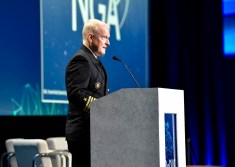Amid a high-stakes transition, questions linger about Project Maven’s future management

More than a half-decade into its existence, the Pentagon’s pioneering artificial intelligence initiative — Project Maven — is in the midst of a major transition that will split the responsibilities for some of its elements between the National Geospatial-Intelligence Agency and the new Chief Digital and Artificial Intelligence Office, while sending its oversight to the Office of the Undersecretary of Defense for Intelligence and Security (I&S).
Many questions remain about how Maven and its complex components will function and scale once that transition is completed early next month. But at this point, one thing is clear: This shift marks a significant waypoint in the project’s evolution and will likely influence the military’s ability to win future wars with AI and associated advanced technologies.
“I think it’ll be hard for me to overstate the importance of this transition. How this transition goes will speak volumes about whether the DOD and intelligence community can really get to speed and scale on AI,” retired Air Force Lt. Gen. Jack Shanahan told DefenseScoop in a recent interview.
During his 36 years of service in the U.S. Air Force, Shanahan accumulated more than 2,800 flight hours. He went on to work in DOD’s I&S directorate, before DOD’s Joint Artificial Intelligence Center (JAIC) was formed in 2018 and he was named as its inaugural director.
Its genesis was partially inspired by the creation of Project Maven in April 2017, which the lieutenant general also played a key role in establishing.
In simplest terms, Project Maven was created to enable the military to apply computer vision — an aspect of machine learning and deep learning that autonomously detects, tags and tracks objects or humans of interest from still images or videos captured by surveillance aircraft, satellites and other means.
Technological advancements, higher stakes global competition and many other factors influenced Maven’s origins. But Shanahan said a primary motivator was the need to make sense of the “staggering” amounts of data that were coming off of technology platforms monitoring conflict zones in the Middle East.
By the end of its first year in existence, “we had our first models in combat operations,” Shanahan explained. Those initial efforts did not unfold without some publicized controversy, but by the time he retired from the Pentagon in 2020, Shanahan said that the capabilities were being applied in “all the key” Middle Eastern countries where combat was unfolding. To him, the project marked a monumental early AI-driving win for DOD.
In February 2022, the JAIC was among multiple organizations absorbed into the then-established CDAO. Two months after that, the Biden administration proposed restructuring the organization and responsibilities associated with Project Maven and assigning new leads.
“Maven was the ‘Big Bang,’ and at some point, you’re so far away, you forget where the light came from,” Shanahan said. “But it was the Big Bang and I hope that we get a universe called ‘the AI-enabled Department of Defense’ out of that Big Bang.”
Blurry vision
Still, the initiative’s future organization and functions remain at this point unclear.
When Maven’s transition was first announced in the spring, it was generally billed as operational control being fully transferred to NGA.
But in August, on a trip to government technology facilities in the Midwest, Deputy Defense Secretary Kathleen Hicks told DefenseScoop about her aims to help DOD make a drastic move from a hardware-centric to a software-centric enterprise. She said the CDAO was established under her purview to become a sort of “technical architect” in this work.
“We brought in world-class talent into that CDAO and we’ve paired [its fresh leadership] now with folks like the Maven community that we’ve pulled into CDAO, [who] understand how to connect at a more tactical operational level to the AI-data-level talent,” she explained. “And they’re going to be really focused on creating that integration layer at the software level.”
At this point, however, only a few details about how Maven will function and be steered in its next phase beyond that have been widely shared. The project is currently designated as part of “defense critical infrastructure,” which might partly contribute to why officials are tight-lipped.
Spokespersons from the CDAO and NGA recently confirmed to DefenseScoop that their organizations are considered “mission partners” in the work. Lines of effort associated with Maven’s GEOINT functions — meaning those that analyze geospatial intelligence, or signals and data of specific locations — will move to NGA by the start of fiscal 2023.
“CDAO is responsible for continuing development on the non-GEOINT lines of effort until such time as they are ready to transition to follow-on mission partners,” which will be fully moved over by fiscal 2025, statements from the press officials said. They also noted that “ongoing work post-transitioned will be overseen by [I&S,]” and that “details of that oversight function are still being established.”
When asked for further clarity regarding which of those organizations is responsible specifically for AI governance, scaling and other major tasks in Maven’s near future, the spokespersons from CDAO and NGA referred DefenseScoop to I&S.
A press official from that office did not respond to DefenseScoop’s repeated requests for more information by deadline.
To Shanahan, this shift represents “maybe the single most important transition in the next couple of years.”
Having been there since its very beginning, he said he admires Maven more than perhaps any other person. But despite his team’s work to enable the use of its assets across the military, for now it still encompasses just one AI program within DOD.
“If it doesn’t transition successfully, Maven could be just seen as another fantastic individual siloed project. We never saw it that way. In fact, the one thing that I didn’t think it would ever be called is siloed,” Shanahan said.
The CDAO, NGA and I&S must cooperatively embrace their duties to take this project to the next level, he added — “because if this doesn’t go well, it’s not a good signal for the rest of the government.”
The ‘vision of the future’
Currently, Project Maven capabilities are being used operationally in Europe.
“And that’s about all I can say, because I’m not day-to-day tied in, in terms of classified sources — but I know it’s being used and being used effectively. So, I think they’ve sort of pushed the envelope almost as far as they can go by Maven itself,” Shanahan said. “Now it’s time to get this to the entire Department of Defense and the entire intelligence community.”
Looking back, he noted that Maven started with a focus on the “most basic problem,” which was object detection, classification and tracking. Over time, Shanahan and the team built-in more capabilities, he said, to help military analysts address questions like “what kind of vehicle? What kind of building? Was the person carrying a weapon, or not carrying a weapon? Can we get to [identifying] an adult and child? Yes, we could. Could you [track] an adult carrying a weapon? Yes, you could.”
Training the AI to properly denote the likely expressed gender of humans that were spotted was “a tougher problem to solve,” the retired military executive said.
Eventually Project Maven’s components became more and more sophisticated with additional classes of identifiable objects and capacity to function across imagery from both day and night.
To Shanahan, one of its most important abilities allowed analysts to easily trail back across forensic data of crucial events.
“So an [improvised explosive device attack] happened. I want to know where that vehicle came from in the last 24 hours. It would take an analyst forever to do that. The machine? Boom — there it is,” Shanahan said. “I mean, eventually, you get to the point where you’re saying ‘I want to look just for this vehicle — this red Toyota Land Cruiser, or white Toyota Hilux’ — whatever it was. It’s a hard problem to do it, especially, across 24 hours and all the way back. But it’s doable, and we showed it was doable.”
Layers of AI and machine learning continue to be built on Maven. But to Shanahan, some of its early uses were part of “the beginning” of human-machine teaming for military missions.
“In this case, it’s a coder working with an operator saying ‘what do you want to know? How? How do I tell you when I really want you to focus over here?’” he explained. “So the idea of the machine doing what the machine does best — like getting through as much data as you could possibly get through and finding a signal out of noise. Because it’s noise, noise, noise — it’s combat, everything’s happening simultaneously. Bad shit. People all over the place. Tell me what I need to focus on and what’s really important to me.”
Maven continues to encompass new and different types of computer vision and advance in its offerings, but inherently, it has really always been intended to help analysts and computers to work together.
“To me, that’s the vision of the future,” Shanahan noted.
The former Maven leader briefed DefenseScoop on multiple occasions for this piece. In the most recent conversation, he expressed more hope than in previous chats about Maven’s ongoing transition and ultimate future.
Shanahan said he “completely agrees” with Hicks’ recent intent on pushing DOD’s emerging technology pursuits to their next iterations.
“So her focus is on what I would also say is appropriate — now it’s about experimentation and wargaming, and trying this stuff out creatively. Because the innovation will never ever, ever, ever come from the Pentagon, it will come from the people using this technology in new and unexpected and creative ways,” he noted.
If service members can’t “play around” with the capabilities, or are forced to try them, the solutions could potentially be disregarded. Going forward, he’d like to hear about more experimentation with Maven’s functions in the military’s pre-deployment training, fleet and bomb exercises, and combatant commands.
If that happens in the next couple years, it could lead to “an explosion of ideas that no one knew about because they weren’t being tried out at the so-called tactical and operational” levels, according to Shanahan.
Though a little skepticism remains, in the most recent conversation with DefenseScoop, he also explicitly pointed out that he feels “more optimistic than ever” about this point in Maven’s transition, because he has heard that new NGA director Vice Adm. Frank Whitworth has made Maven “his priority project.”
“Really what I wanted to hear is that he was going to embrace this. Maybe he changes the name — it doesn’t matter to me. But he understands how damn important it is to make this work,” Shanahan said.
Editor’s note: This piece is the first of a series that DefenseScoop is reporting on Project Maven. Have a tip? Email Brandi.Vincent@defensescoop.com.






